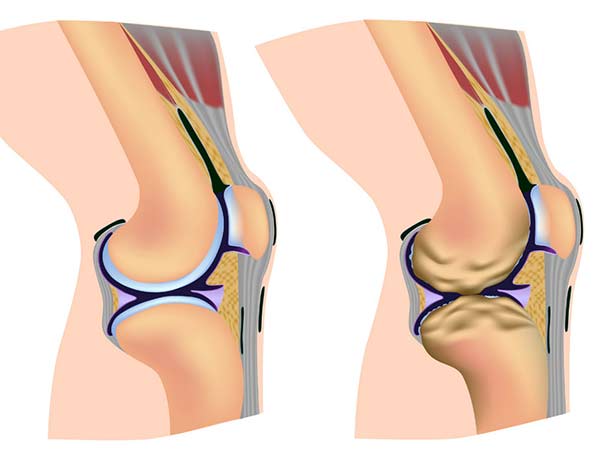Zoledronic acid shows no effect on knee pain or bone marrow lesions in knee osteoarthritis after two years
Some symptomatic benefit was seen in patients with milder disease
The results of a study presented at the Annual European Congress of Rheumatology (EULAR 2018) show that a one-yearly infusion of zoledronic acid (ZA) did not significantly reduce knee pain or bone marrow lesion (BML) size overall in knee osteoarthritis patients over two years. However, it may have symptomatic benefit in milder disease.1
 Osteoarthritis is a common condition that makes a person’s joints stiff and painful, particularly in the morning. One of the causes is thinning of the cartilage within the joints, which allows the bones to rub against each other. Joint swelling and pain are frequent symptoms. It is the most common of all the different types of arthritis, and typically becomes more common as people get older.
Osteoarthritis is a common condition that makes a person’s joints stiff and painful, particularly in the morning. One of the causes is thinning of the cartilage within the joints, which allows the bones to rub against each other. Joint swelling and pain are frequent symptoms. It is the most common of all the different types of arthritis, and typically becomes more common as people get older.
“Osteoarthritis currently affects over 40 million Europeans and has a significant societal impact on sufferers and economic burden on health systems, this is only set to escalate in a rapidly ageing population,” said Professor Thomas Dörner, Chairperson of the Abstract Selection Committee, EULAR. “There are very limited effective treatment options for the disease and bone marrow lesions remain an important therapeutic target.”
Promising results from a pilot study previously conducted in 59 adults showed a single infusion of zoledronic acid reduced knee pain and BML size in knee osteoarthritis patients over six months.2 The results presented were from a multicentre, randomised, double-blinded, placebo-controlled trial that was designed to assess whether these improvements could be reproduced in a larger cohort over two years.
“It is disappointing that our results have not replicated the positive findings of the initial pilot study,” said Professor Graeme Jones, Menzies Institute for Medical Research (study author). “However, there may be a role for zoledronic acid to relieve symptoms in patients with mild osteoarthritis.”
Results showed that after 24 months, there were no significant changes in knee pain (WOMAC* pain score: -37.5 vs -11.7, p=0.205; VAS† pain score: -11.5 vs -16.8, p=0.17), WOMAC* function score (-134.9 vs -159.2, p=0.65), or knee BML size (-33.5mm2 vs – 11.7mm2, p=0.68) between the zoledronic acid group and placebo group respectively. However, pre-specified analyses consistently showed that ZA was more effective than placebo in patients without radiographic osteoarthritis (joint space narrowing (JSN) Grade 0) on changes in WOMAC pain (-88.3 vs -42.6, p=0.21), VAS pain (-21.8 vs -8.3, p=0.11), WOMAC function (-296.9 vs -78.5, p=0.06) and BML size (-67.4 vs 98.2, p=0.14). Adverse events were more frequent in the ZA group, primarily flu-like symptoms and musculoskeletal pain and stiffness.1
The study was a multicentre, randomised, double-blinded, placebo-controlled trial over two years. There were 223 patients enrolled in the study who were 50 years or older and who had significant knee pain‡ and MRI-detected knee BML. Severe knee osteoarthritis patients were excluded. The mean age of participants was 62 and 52% were female. The baseline mean WOMAC* scores for pain and function were 200/500 and 657/1700 respectively. The mean VAS† pain score was 51/100 and the median BML size was 489.6mm2. Patients were randomized to receive either ZA or placebo once-yearly.1
Source: European League Against Rheumatism (EULAR)
Full bibliographic information
1 Cai G, Aitken D, Laslett L, et al. A multicentre randomised controlled trial of zoledronic acid for osteoarthritis of the knee with bone marrow lesions. EULAR 2018; Amsterdam: Abstract OP0016.
2 Laslett LL, Dore DA, Quinn SJ, et al. Zoledronic acid reduces knee pain and bone marrow lesions over 1 year: a randomised controlled trial. Ann Rheum Dis. 2012;71(8):1322-8.
3 van der Heijde D, et al. Common language description of the term rheumatic and musculoskeletal diseases (RMDs) for use in communication with the lay public, healthcare providers and other stakeholders endorsed by the European League Against Rheumatism (EULAR) and the American College of Rheumatology (ACR). Annals of the Rheumatic Diseases. 2018;doi:10.1136/annrheumdis-2017-212565. [Epub ahead of print].
4 EULAR. 10 things you should know about rheumatic diseases fact sheet. Available at: https://www.eular.org/myUploadData/files/10%20things%20on%20RD.pdf [Last accessed April 2018].




